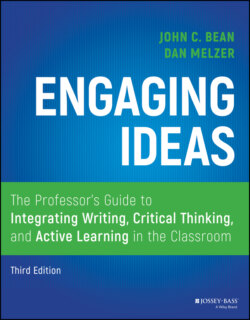Читать книгу Engaging Ideas - John C. Bean - Страница 11
Dan's Perspective on the Third Edition of Engaging Ideas
ОглавлениеMy experiences with Engaging Ideas began long before John invited me to be his coauthor. In my first academic position after graduate school I was hired by California State University, Sacramento to develop a Writing Across the Curriculum program. One of my first goals was to move beyond the occasional professional development workshop and get teachers across disciplines involved in deep and sustained conversations that would have a transformative effect on their pedagogy—and I hoped, in the long run, on the campus culture of writing. I was already aware of the legendary Engaging Ideas—everyone involved in WAC knew of John's book, and every time someone posted a message to the Writing Program Administration or WAC listservs asking for a recommendation for help for leading a faculty development workshop, Engaging Ideas was always the first resource mentioned.
In my WAC seminars, I quickly learned why John's book was so popular. It had a transformative effect on the faculty I was working with. I saw their pedagogies moving toward more critical thinking and extended disciplinary research projects. They began developing a broad array of writing‐to‐learn activities. They began to teach critical reading and not just assign readings. They testified that their response to student writing was becoming more effective, and they created rubrics that clarified their assessment criteria. I've heard similar stories from other campuses. More than any other faculty development book, Engaging Ideas has played a central role in an educational movement that I'm proud to be a part of—Writing Across the Curriculum. I was honored when John invited me to collaborate with him on a third edition.
One final word about the opportunity to work with John. Although I had never worked with John before Engaging Ideas, his reputation as a warm, good‐humored, and collaborative scholar and teacher proceeded him. It was a delight to work with him, and we found that we were able to write with a single voice and a singular sense of purpose. Where our approaches do differ, you'll find that we describe our different pedagogies in detail in our own voices and we hope provide readers with a more multivocal book and an even richer menu of pedagogical options than those provided in the second edition.
